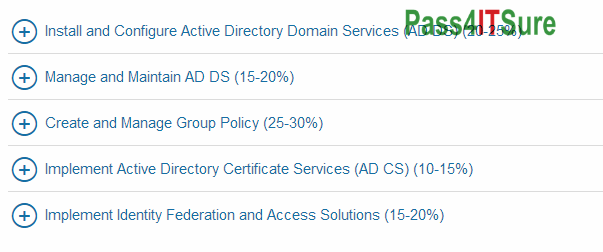Pass4itsure is the best website for Microsoft 70-537 exam preparation. https://www.pass4itsure.com/70-537.html Passing Microsoft 70-537 exam– the Most convenient Means.Pass4itsure provides a real and effective Microsoft exam question dumps , as they provide many useful and worthwhile benefits for your final Microsoft 70-537 exam, and they provide accurate and positive material for the final Microsoft 70-537 exam.
[2020 Updated]Newly Launched Microsoft Azure Certifications
| Exam 70-487: Developing Microsoft Azure and Web Services |
| Exam 70-537: Configuring and Operating a Hybrid Cloud with Microsoft Azure Stack |
| Exam 70-774: Perform Cloud Data Science with Azure Machine Learning |
| Exam 70-776: Engineering Data with Microsoft Cloud Services |
Exam 70-537 – Configuring and Operating a Hybrid Cloud with Microsoft Azure Stack
| Deploying and Integrating an Azure Stack Environment | (20-25%) |
| Configuring PaaS and IaaS for an Azure Stack Environment | (25-30%) |
| Providing Services to and Enabling DevOps for Azure Stack Tenants | (25-30%) |
| Maintaining and Monitoring an Azure Stack Environment | (20-25%) |
For more information, you can leap on https://www.microsoft.com/en-us/learning/exam-70-537.aspx
Other MCSA certifications you may be interested in.
The Most convenient Means – Pass4itsure
What do we have?
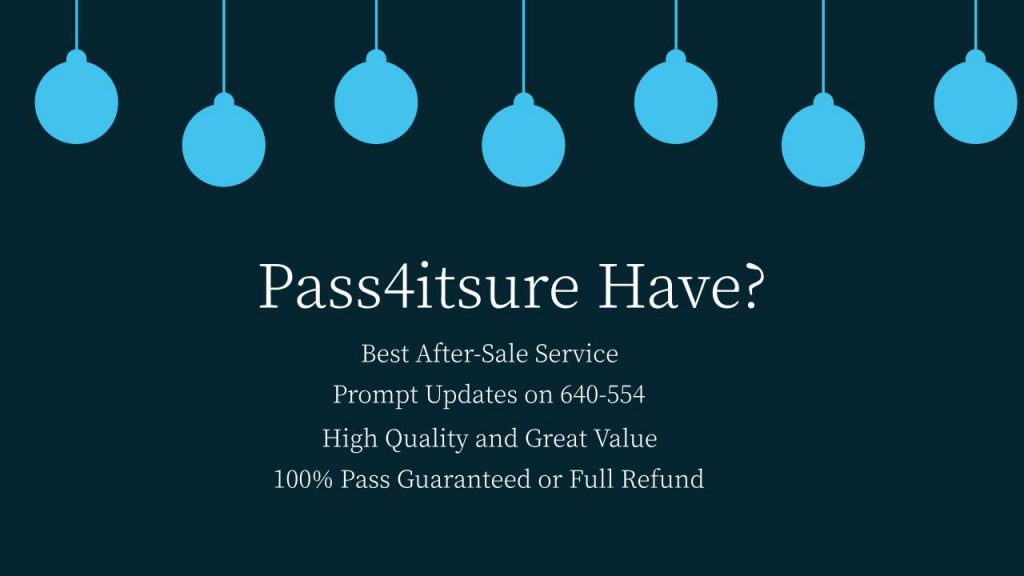
- Pass4itsure 70-537 exam dumps: Our 70-537 pdf dump is the most effective selling Microsoft Azure 70-537 training product, written by highly qualified and experienced experts.
- Pass4itsure Solutions: We will provide them with the most convenient Microsoft 70-537 exam preparation method.
Why you choose?
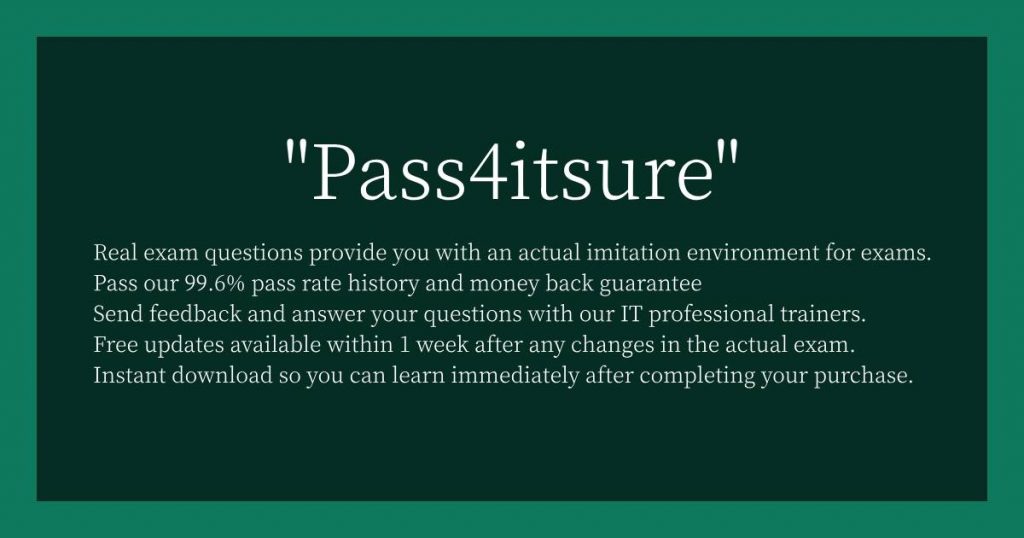
Pass the Microsoft 70–537 Exam
| First, you should get training courses in the classroom or through any online training website. | The recommended website is Pass4itsure -IT Certification Exam. |
| Second, study the official certificate guide. | Microsoft learning |
| Third, practice tests so that you can identify the questions you want to ask. | Pass4itsure practice |
70-537 dumps is the better option for the preparation for the 70-537 exam
(2020 Update)Free Microsoft 70-537 PDF Dumps Download
[google drive]
https://drive.google.com/open?id=1jC-PiBeje3sEFxfJ9On_HvK7Oyt7h63S
Practice, & More Practice(Latest 70-537 Questions and answers )
QUESTION 1
You have an Azure Stack integrated system.
You plan to use the Marketplace publishing tool.
Which two parameters should you specify when you run the tool? Each correct answer presents part of the solution.
NOTE: Each correct selection is worth one point.
A. the Service Admin credentials
B. the Azure Resource Manager endpoint
C. the privileged endpoint
D. a backup location for AzureDeploy.json
E. the cloud administrator credentials
Correct Answer: AB
References: https://docs.microsoft.com/en-us/azure/azure-stack/azure-stack-marketplace-publisher#publishmarketplace-items
QUESTION 2
You have an Azure Stack integrated system that has the following deployment details:
Region: East Naming prefix: azs External domain name: cloud.fabrikam.com
Which URL should you direct tenants to use based on the deployment details?
A. https://adminportal.cloud.fabrikam.com
B. https://portal.east.cloud.fabrikam.com
C. https://portal.azs.cloud.fabrikam.com
D. https://adminportal.azs.cloud.fabrikam.com
E. https://portal.cloud.fabrikam.com
F. https://adminportal.east.cloud.fabrikam.com
Correct Answer: B
References: https://docs.microsoft.com/en-us/azure/azure-stack/azure-stack-integrate-dns#
QUESTION 3
You have an Azure Stack integrated system that uses Microsoft Azure Active Directory (Azure AD) for authentication.
You download and extract the Azure App Service files.
You need to configure the system to support the deployment of Node.js applications and Azure functions.
What should you do before you configure the resource provider?
A. Install certificates. Register a service principal. Deploy and configure a file server. Create a relying party trust.
B. Install certificates. Deploy and configure a file server. Deploy and configure a Microsoft SQL server. Create an Azure
AD application.
C. Install certificates. Register a service principal. Deploy and configure a Microsoft SQL server. Create a relying party
trust.
D. Register a service principal. Deploy and configure a file server. Implement and configure a MySQL resource provider.
Configure the Azure functions.
Correct Answer: B
Incorrect Answers:
A, C: App Service on Azure Stack does not require a service principal or a relying party trust, but does require Microsoft
SQL server for the App Service databases.
D: App Service on Azure Stack requires certificates and Microsoft SQL server for the App Service databases.
References: https://docs.microsoft.com/en-us/azure/azure-stack/azure-stack-app-service-before-you-get-started
QUESTION 4
DRAG DROP
You have an Azure Stack integrated system that uses the external domain name of fabrikam.com.
You need to publish an Azure Marketplace Package (.azpkg) file to the Marketplace.
Which three actions should you perform in sequence? To answer, move the appropriate actions from the list of actions
to the answer area and arrange them in the correct order.
Select and Place:
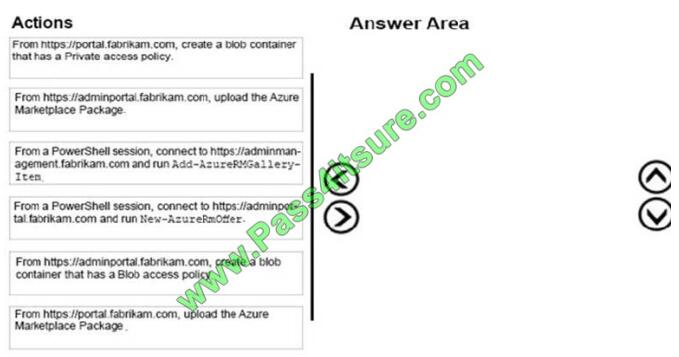
Correct Answer:
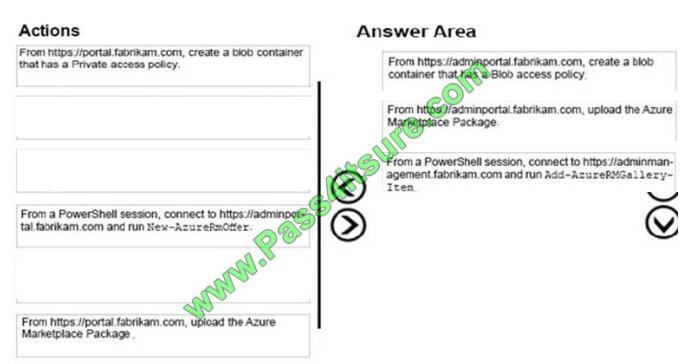
1.Create a blob container. This is a temporary container but it must be publicly accessible.
2.Uploaded the package.
3.Publish the package using the Add-AzureRMGalleryItem cmdlet.
References: https://docs.microsoft.com/en-us/azure/azure-stack/azure-stack-create-and-publish-marketplaceitem#publish-a-marketplace-item
QUESTION 5
You have an Azure Stack integrated system.
What are three source control providers that you can use for App Services? Each correct answer presents a complete
solution.
NOTE: Each correct selection is worth one point.
A. Mercurial
B. DropBox
C. software version control (SVC)
D. BitBucket
E. OneDrive
Correct Answer: BDE
In addition to local Git, the following Source Control Providers are supported: GitHub BitBucket OneDrive DropBox
References: https://docs.microsoft.com/en-us/azure/azure-stack/azure-stack-app-service-configure-deploymentsources
QUESTION 6
Your network contains an Active Directory forest named adatum.com.
You deploy an Azure Stack integrated system.
You implement federation between adatum.com and Azure Stack.
You need to ensure that a user named [email protected] can manage Azure Stack from the Azure Stack
administrator portal.
Which cmdlet should you run?
A. Set-ServiceAdminOwner
B. Set-AzsUserSubscription
C. New-CloudAdminUser
D. Set-CloudAdminPassword
Correct Answer: A
References: https://docs.microsoft.com/en-us/azure/azure-stack/azure-stack-integrate-identity
QUESTION 7
NOTE: This question is part of a series of questions that present the same scenario. Each question in the series
contains a unique solution that might meet the stated goals. Some question sets might have more than one correct
solution,
while others might not have a correct solution.
After you answer a question in this section, you will NOT be able to return to it. As a result, these questions will not
appear in the review screen.
You have an Azure Stack integrated system that runs in a connected environment.
You need to recommend an interval for installing Microsoft software update packages to Azure Stack. The solution must
ensure that you can receive Microsoft support.
Solution: You recommend that Microsoft software updates be installed monthly.
Does this meet the goal?
A. Yes
B. No
Correct Answer: A
For your Azure Stack deployment to remain in support, it must run the most recently released update version or run
either of the two preceding update versions.
Microsoft will release update packages for Azure Stack integrated systems on a regular cadence that will typically fall on
the fourth Tuesday of every month.
Thus to remain in support you must be running one of the last three update versions and, as an update version is
released every month, you need to install updates at least every three months.
References:
https://docs.microsoft.com/en-us/azure/azure-stack/azure-stack-servicing-policy https://docs.microsoft.com/enus/azure/azure-stack/azure-stack-updates
QUESTION 8
You have an Azure Stack integrated system that has 100 tenants.
You create a new offer that is Private.
You need to provide the offer to a tenant.
What should you do?
A. Delegate rights to the tenant user, and then instruct the tenant user to create a new subscription.
B. Create a new subscription, and then assign the subscription to the tenant.
C. Run the New-AzsOffer cmdlet, and then specify the tenant user account.
D. Run the Set-AzsUserSubscription cmdlet, and then specify the subscription of the tenant user.
Correct Answer: B
When you create an offer, you must include at least one base plan, but you can also create add-on plans that users can
add to their subscription. A subscription is how users access your offers.
After you create an offer, users need a subscription to that offer before they can use it.
You can create subscriptions for both public and private offers. If do not want your tenants to create their own
subscriptions, make all of your offers private, and then create subscriptions on behalf of your tenants. This approach is
common
when integrating Azure Stack with external billing or service catalog systems.
After you create a subscription for a user, that user can log into the user portal and will find that they are subscribed to
the offer.
Incorrect Answers:
A: As the Azure Stack operator, you can delegate the creation of offers and users to other users by using the delegation
functionality.
C: The New-AzsOffer cmdlet creates an offer composing of the specified base plans and add-on plans.
D: The Set-AzsSubscription cmdlet modifies the current logged-in user\\’s tenant subscription.
References: https://docs.microsoft.com/en-us/azure/azure-stack/azure-stack-delegated-provider
https://docs.microsoft.com/en-za/powershell/module/azurerm.azurestackadmin/new-azsoffer?view=azurestackps-1.2.11
https://docs.microsoft.com/en-za/powershell/module/azurerm.azurestackadmin/setazssubscription?view=azurestackps-1.2.11 https://docs.microsoft.com/en-us/azure/azure-stack/azure-stack-subscribeplan-provision-vm
QUESTION 9
Note: This question is part of a series of questions that use the same scenario. For your convenience, the scenario is
repeated in each question. Each question presents a different goal and answer choices, but the text of the scenario is
exactly the same in each question in this series.
Start of repeated scenario.
Your company has a main office in New York and a branch office in Toronto. Each office has a dedicated connection to
the Internet. Each office has a firewall that uses inbound and outbound rules.
The company has an on-premises network that contains several datacenters. The datacenters contain multiple
hypervisor deployments, including Window Server 2016 Hyper-V. The network uses Microsoft System Center for monitoring and
Windows Azure Pack for self-service.
The company has a Microsoft Azure subscription that contains several workloads. You use Azure Resource Manager
templates and other automated processes to create and manage the resources in Azure.
You have an Azure Stack integrated system in the New York office. The company has a development team in the
Toronto office and a development team in the New York office. The system has an offer named Offer1. Several tenants
have
subscriptions based on Offer1.
You have a Hyper-V host named Server1 that runs Windows Server 2012 R2. Server1 is used for testing. The hardware
on Server1 can support the deployment of the Azure Stack Development Kit.
You have a Generation 1 virtual machine named VM1 that runs Windows Server 2012 R2. VM1 is deployed to a HyperV host that runs Windows Server 2016. VM1 has a fixed size disk named VM1.vhdx that is 200 GB.
End of repeated scenario.
You implement a SQL Server resource provider that uses D14v2 virtual machines.
A tenant creates a SQL database that runs several heavy workloads. The tenant reports that SQL queries are slow to
complete.
You need to recommend changes to the Azure Stack integrated system to reduce the amount of time required to
complete the SQL queries.
What should you recommend?
A. Resize the virtual machine that provides the Microsoft SQL Server service.
B. Instruct the tenant to install Microsoft SQL Server on a virtual machine in its subscription.
C. In the Azure Stack integrated system, cluster the D14v2 virtual machines.
D. Deploy a physical server that has more resources that the D14v2 virtual machines. Install Microsoft SQL Server on
the server. Add the server to the SQL Server resource provider.
Correct Answer: D
QUESTION 10
HOTSPOT
You have an Azure Stack integrated system.
You need to install the Azure Stack-compatible Azure PowerShell modules on a management workstation.
You set the $profile variable to the correct API version.
Which commands should you run? To answer, select the appropriate options in the answer area.
NOTE: Each correct selection is worth one point.
Hot Area:
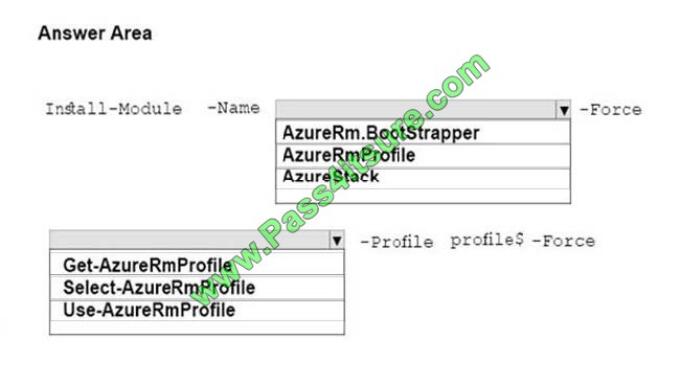
Correct Answer:
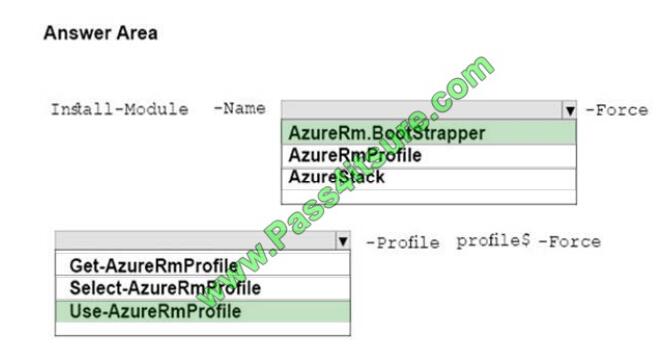
References: https://docs.microsoft.com/en-us/azure/azure-stack/azure-stack-powershell-install
QUESTION 11
NOTE: This question is part of a series of questions that present the same scenario. Each question in the series
contains a unique solution that might meet the stated goals. Some question sets might have more than one correct
solution,
while others might not have a correct solution.
After you answer a question in this section, you will NOT be able to return to it. As a result, these questions will not
appear in the review screen.
You have an Azure Stack integrated system that contains four nodes named Node1, Node2, Node3 and Node4.
You plan to replace Node2.
You need to drain the active workloads that run on Node2.
Solution: You connect to the BMC web interface on Node2 and power off the node.
Does this meet the goal?
A. Yes
B. No
Correct Answer: B
The Drain action evacuates all active workloads by distributing them among the remaining nodes in that particular scale
unit. To run the drain action through PowerShell, use the Disable-AzsScaleUnitNode cmdlet.
Incorrect Answers:
A: The BMC web interface on Node2 can be used to power off the node. This does not send a shutdown signal to the
operating system. For planned power off operations, make sure you drain a scale unit node first. References:
https://docs.microsoft.com/en-us/azure/azure-stack/azure-stack-replace-node
QUESTION 12
Note: This question is part of a series of questions that use the same scenario. For your convenience, the scenario is
repeated in each question. Each question presents a different goal and answer choices, but the text of the scenario is
exactly the same in each question in this series.
Start of repeated scenario.
Your company has a main office in New York and a branch office in Toronto. Each office has a dedicated connection to
the Internet. Each office has a firewall that uses inbound and outbound rules.
The company has an on-premises network that contains several datacenters. The datacenters contain multiple
hypervisor deployments, including Window Server 2016 Hyper-V. The network uses Microsoft System Center for
monitoring and
Windows Azure Pack for self-service.
The company has a Microsoft Azure subscription that contains several workloads. You use Azure Resource Manager
templates and other automated processes to create and manage the resources in Azure.
You have an Azure Stack integrated system in the New York office. The company has a development team in the
Toronto office and a development team in the New York office. The system has an offer named Offer1. Several tenants
have
subscriptions based on Offer1.
You have a Hyper-V host named Server1 that runs Windows Server 2012 R2. Server1 is used for testing. The hardware
on Server1 can support the deployment of the Azure Stack Development Kit.
You have a Generation 1 virtual machine named VM1 that runs Windows Server 2012 R2. VM1 is deployed to a HyperV host that runs Windows Server 2016. VM1 has a fixed size disk named VM1.vhdx that is 200 GB.
End of repeated scenario.
You need to ensure that you can import VM1 to Azure Stack.
What should you do?
A. Recreate VM1 as a Generation 2 virtual machine.
B. Convert the disk to a VHD.
C. Convert the disk to a dynamically expanding disk.
D. Upgrade VM1 to Windows Server 2016.
Correct Answer: B
Azure supports only generation 1 VMs that are in the VHD file format and have a fixed sized disk. The maximum size
allowed for the VHD is 1,023 GB. You can convert a generation 1 VM from the VHDX file system to VHD and from a
dynamically expanding disk to fixed-sized. But you can\\’t change a VM\\’s generation.
Incorrect Answers:
A: Azure supports only generation 1 VMs that are in the VHD file format.
C: Azure Stack does not support dynamic VHDs. Resizing a virtual machine (VM) with a dynamic disk attached to it
leaves the VM in a failed state.
References: https://docs.microsoft.com/en-za/azure/virtual-machines/windows/prepare-for-upload-vhd-image
https://docs.microsoft.com/en-us/azure/azure-stack/azure-stack-update-1802
QUESTION 13
You have two Azure Stack integrated systems name Stack1 and Stack2.
You create an Azure Resource Manager template that successfully deploys to Stack1.
You attempt to deploy the template to Stack2, but the deployment fails.
What is a possible cause of the deployment failure?
A. Stack1 has Azure Marketplace syndication disabled and Stack2 has Azure Marketplace syndication enabled.
B. The template was deployed to Stack2 by using Microsoft Visual Studio.
C. The API version used in the template is a later version that the API version available on Stack2.
D. Stack1 has Azure Marketplace syndication enabled and Stack2 has Azure Marketplace syndication disabled.
Correct Answer: C
References: https://docs.microsoft.com/en-us/azure/azure-stack/user/azure-stack-considerations#version-requirements
Microsoft 70-537 dumps – Pass4itsure discount
Use “2020PASS” Discount Code, Get a 12% discount !

Summarize:
Download Full Exam & Pass 100% Success Guaranteed: https://www.pass4itsure.com/70-537.html.
